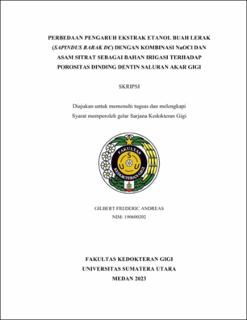| dc.description.abstract | Root canal preparation generates layers of organic and inorganic materials,
necessitating an ideal irrigation material. Commonly used irrigation materials are
NaOCl combined with EDTA or citric acid, which can cause dentin to become porous,
resulting in a reduction in dentin strength. Due to the shortcomings of these irrigation
materials, a natural and more biocompatible substance such as Lerak fruit extract is
needed. Lerak fruit can dissolve both organic and inorganic components while reducing
surface tension, thereby increasing dentin permeability. The aim of this research is to
determine the differences between Lerak extract and a combination of NaOCl and citric
acid as irrigation materials in terms of the porosity of dentin walls in root canals. The
research design employed a post-test control group design using 40 mandibular
premolar teeth and divided into 4 groups. The samples were prepared using a manual
step-back technique, then irrigated with each treatment group. Subsequently, the
samples were cut buccolingually, and porosity was observed using a Scanning Electron
Microscope. The first group was irrigated with 12.5% ethanol extract of Lerak fruit,
the second group with 2.5% NaOCl followed by 12.5% ethanol extract of Lerak fruit,
the third group with 2.5% NaOCl followed by 10% citric acid, and the fourth group
with saline. Shapiro-Wilk normality tests revealed normal data distribution in groups 1
and 2, but in groups 3 and 4, the data is not normally distributed.. Levene's test indicated
homogeneity of data variance. The Kruskal-Wallis test resulted in p=0.000 (p<0.05),
indicating a significant influence, followed by Post Hoc tests. Based on the data irrigation with Lerak extract produced smaller porosity compared to the combination
of NaOCl with Lerak and the combination of NaOCl with citric acid | en_US |


